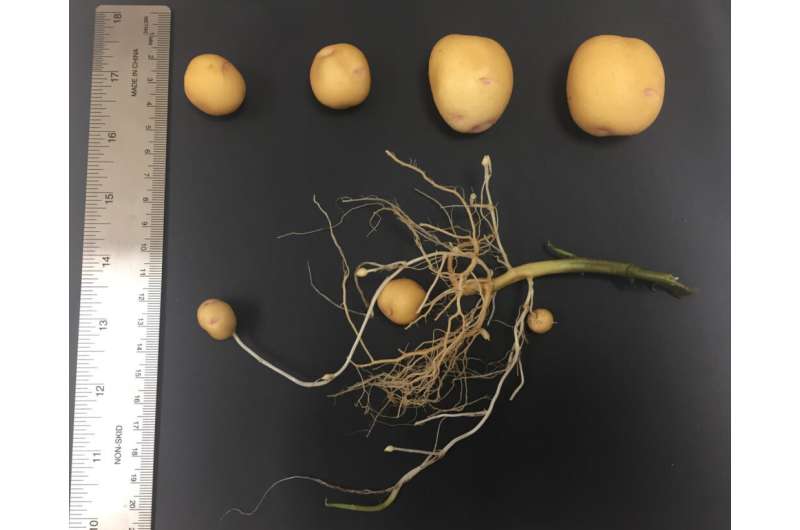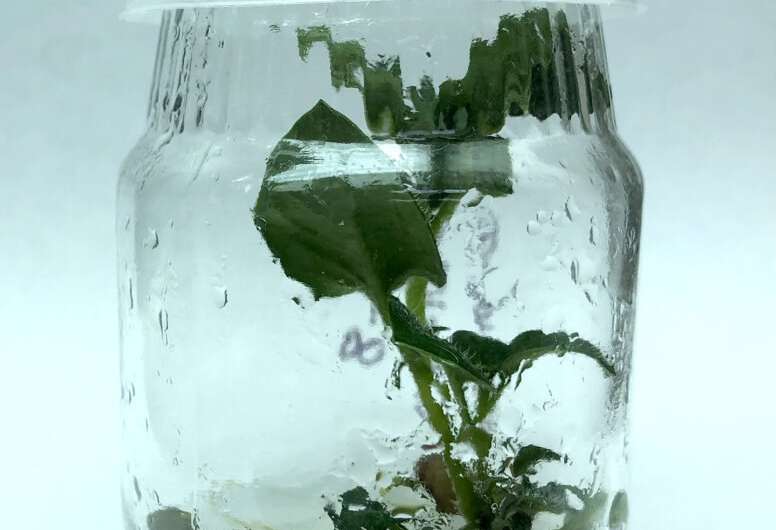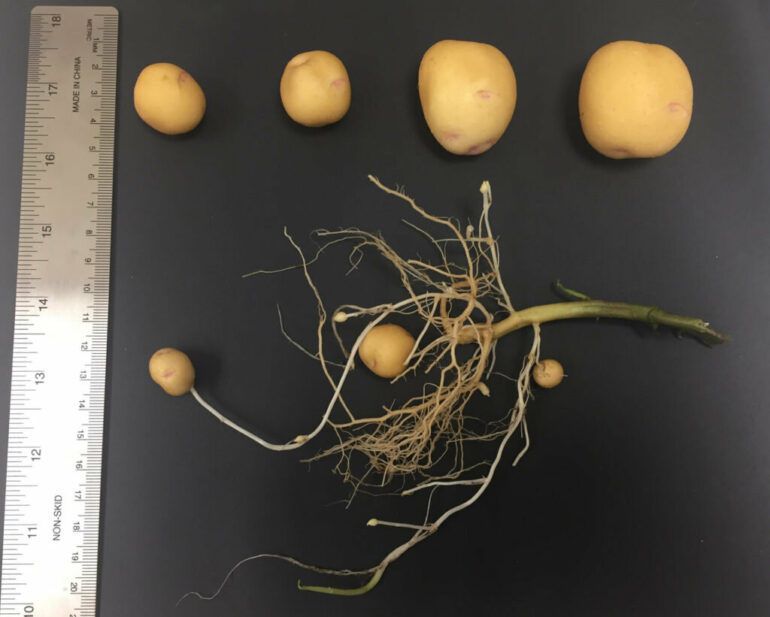Humble potatoes are a rich source not only of dietary carbohydrates for humans, but also of starches for numerous industrial applications. Texas A&M AgriLife scientists are learning how to alter the ratio of potatoes’ two starch molecules—amylose and amylopectin—to increase both culinary and industrial applications.
For example, waxy potatoes, which are high in amylopectin content, have applications in the production of bioplastics, food additives, adhesives and alcohol.
Two articles recently published in the International Journal of Molecular Sciences and the Plant Cell, Tissue and Organ Culture journals outline how CRISPR technology can advance the uses of the world’s largest vegetable crop.
Both papers include the work done by Stephany Toinga, Ph.D., who was a graduate student in the lab of Keerti Rathore, Ph.D., AgriLife Research plant biotechnologist in the Texas A&M Institute for Plant Genomics and Biotechnology and Department of Soil and Crop Sciences. Also co-authoring both papers was Isabel Vales, Ph.D., an AgriLife Research potato breeder in the Texas A&M Department of Horticultural Sciences. Toinga is now a Texas A&M AgriLife Research postdoctoral associate with Vales.
“The information and knowledge we gained from these two studies will help us introduce other desirable traits in this very important crop,” Rathore said.
Potato facts
Potatoes are the No. 1 vegetable crop worldwide and the third most important human food crop, only behind rice and wheat in global production. Potatoes are grown in over 160 countries on 40.8 million acres and serve as a staple food for more than a billion people.
With a medium-size potato supplying approximately 160 calories, mostly derived from starch, the tubers constitute an important energy source for many people worldwide, Rathore said. Potatoes also provide other necessary nutrients, including vitamins and minerals.

Tubers from one of the edited lines of potatoes in the Texas A&M AgriLife study. If these are put into soil, they will produce a normal potato plant with normal size tubers. © Texas A&M AgriLife / Stephany Toinga
Potatoes are a cool-season crop that is relatively sensitive to heat and drought stress. The crop also suffers from pests such as Colorado beetle, aphids and nematodes, as well as diseases including early and late blight, zebra chip, Fusarium dry rot and a number of viral diseases. Late blight was the cause of the Irish potato famine.
Starch is key for both dietary and industrial uses
The amount of starch in potato tubers is the main factor that determines a potato’s use. High-starch potatoes are often used to make processed foods such as French fries, chips and dehydrated potatoes, Vales said.
Potatoes with low to medium starch levels are frequently used for the fresh or table stock market, she said. For the fresh market, additional important considerations are tuber appearance, including skin texture, skin color, flesh color and tuber shape. Recently, specialty potato types with different shapes, such as fingerlings; smaller sizes; and red, purple or yellow skin and flesh colors are becoming popular because of their convenience in cooking and increased nutritional value.
Potato tuber shape is less important for industrial purposes than it is for human consumption, Vales said. Potato tubers with external deformities caused by heat or drought stress or other factors can be redirected to myriad uses, including food for dogs and cattle. In addition, potato starch can produce ethanol for fuel or in beverages like vodka; a biodegradable substitute for plastics; or adhesives, binders, texture agents and fillers for the pharmaceutical, textile, wood and paper industries, and other sectors.
For industrial applications, the amount and type of starch in a potato are important considerations.
Toinga said starches higher in amylopectin are desirable for processed food and other industrial applications due to their unique functional properties. For example, such starches are the preferred form for use as a stabilizer and thickener in food products and as an emulsifier in salad dressings. Because of its freeze-thaw stability, amylopectin starch is used in frozen foods. Additionally, potatoes rich in amylopectin starch yield higher ethanol levels compared to those with other starches.
The benefits of breeding potatoes with select starches
Developing potato cultivars with modified starch could open new opportunities, Toinga said. Potatoes with high amylopectin and low amylose, like the gene-edited Yukon Gold strain she described in the International Journal of Molecular Sciences, have industrial applications beyond traditional uses.
In contrast, potatoes with high amylose levels and low amylopectin would be desirable for human consumption, Vales said. The amylose acts like fiber and does not liberate glucose as easily as amylopectin, thus resulting in a lower glycemic index and making potatoes more acceptable for people with diabetes.

A knockout line in culture that has produced miniature potatoes called microtubers. © Texas A&M AgriLife / Stephany Toinga
CRISPR/Cas9 creates new options
CRISPR/Cas9 technology has expanded the toolset available to breeders, Vales said, and it represents a more direct, faster means to incorporate desired traits into popular commercial crop varieties. Conventional breeding is a lengthy process that can take 10–15 years.
In addition, she said, due to the complex nature of the potato genome, generating new cultivars with the right complement of desirable traits is challenging for conventional breeding. Molecular breeding has enhanced breeding efficiencies, and gene-editing using the CRISPR/Cas9 technology adds another level of sophistication.
“We utilized the Agrobacterium method to deliver the CRISPR reagents into potatoes because it is reliable, efficient and least expensive compared to all other delivery methods,” Rathore said.
In the first study, highlighted in the Plant Cell, Tissue and Organ Culture article, a potato line containing four copies of gfp, a jellyfish gene that allows a fluorescence-based visualization of the gene’s activity, was targeted for mutation using the CRISPR/Cas9 system, Toinga said.
In essence, this project provided an easy-to-see trait that enabled researchers to optimize the methodology.
“Loss of the characteristic green fluorescence and sequencing of the gfp gene following CRISPR treatment indicated that it is possible to disrupt all four copies of the gfp gene, thus confirming that it should be possible to mutate all four alleles of a native gene in the tetraploid potato,” Rathore said.
An improved Yukon Gold cultivar
Among the various potato cultivars evaluated in the first study, the Yukon Gold strain regenerated the best, and so it was used for the second study. In the second knockout study, described in the International Journal of Molecular Sciences, the native gene gbss in the tetraploid Yukon Gold strain was targeted to effectively eliminate amylose. The result was a potato with starch rich in amylopectin and low in amylose.
“One of the knockout events, T2-7, showed normal growth and yield characteristics but was completely devoid of amylose,” Toinga said.
That tuber starch, T2-7, could find industrial applications in the paper and textile sectors as adhesives/binders, bioplastics and ethanol industries. Tuber starch from this experimental strain, because of its freeze-thaw stability without the need for chemical modifications, should also be useful in producing frozen foods. Potatoes with amylopectin as the exclusive form of starch should also yield more ethanol for industrial use or to create alcoholic beverages.
As the next step for these studies, the T2-7 strain has been self-pollinated and crossed with the Yukon Gold strain donor and other potato clones to eliminate the transgenic elements.
More information:
Stephany Toinga-Villafuerte et al, CRISPR/Cas9-Mediated Mutagenesis of the Granule-Bound Starch Synthase Gene in the Potato Variety Yukon Gold to Obtain Amylose-Free Starch in Tubers, International Journal of Molecular Sciences (2022). DOI: 10.3390/ijms23094640
Stephany Toinga-Villafuerte et al, Green fluorescent protein gene as a tool to examine the efficacy of Agrobacterium-delivered CRISPR/Cas9 reagents to generate targeted mutations in the potato genome, Plant Cell, Tissue and Organ Culture (PCTOC) (2022). DOI: 10.1007/s11240-022-02310-8
Provided by
Texas A&M University
Citation:
Researchers use CRISPR technology to modify starches in potatoes (2022, May 25)



